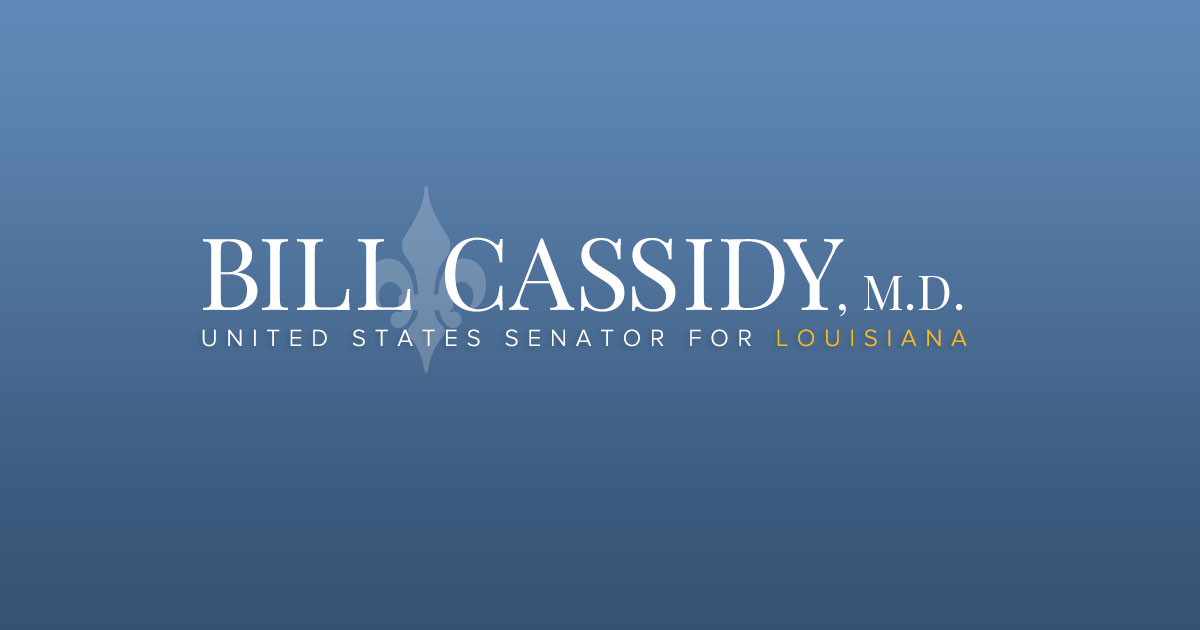Source: United States Senator for Louisiana Bill Cassidy
09.15.21
WASHINGTON – U.S. Senator Bill Cassidy, M.D. (R-LA) today delivered a speech on the Senate Floor renewing his calls for disaster supplemental relief in the wake of Hurricane Ida, the fifth most powerful storm to ever hit the United States.
“Recovery is two-pronged approach. It starts with aid and finishes with the bipartisan infrastructure bill. A bill that helps our communities rebuild from past storms and better prepares our communities for future storms. Louisianans are strong. Louisianans are resilient. But we need long awaited supplemental disaster aid. Let’s finally get it done,” said Dr. Cassidy.
In the weeks since Hurricane Ida made landfall, Cassidy has toured damage left by the storm in St. Tammany, Livingston, Lafourche and Terrebonne Parishes, and surveyed damage in a flyover with the U.S. Coast Guard.
Cassidy’s speech as prepared for delivery can be found below:
Mr. President,
Just a few weeks ago, southeast Louisiana was pummeled by Hurricane Ida on the 16th anniversary of Hurricane Katrina’s landfall. Ida knocked out power across the state, including the entire City of New Orleans. The storm brought intense flooding that took lives and devastated communities.
Hurricane Ida struck Louisiana’s shores as a Category 4 storm, with winds as high as 150 miles per hour, making it the fifth most powerful storm to ever hit the United States. Ida hit just two days after the one-year anniversary of Hurricane Laura, which at the time (August 27, 2020) was the strongest storm to hit Louisiana in 164 years. Laura devastated southwest Louisiana.
Unfortunately, Louisiana is no stranger to extreme weather. 2020 set a record nationally for the most named storms in a single season, with 30, five of which made landfall in Louisiana. Last year, Louisiana farmers were also hit with catastrophic damage to livestock, crops and structures during unprecedented winter storms.
In the aftermath of Ida, 29 Louisianans, 85 total American lives, have been lost, and yesterday was the first day the number of Louisianans without power dipped below six figures. Those in Lafourche Parish and Lower Jefferson Parish are estimated to have the power restored on September 29, that’s still two weeks from today and a month after Ida made landfall on August 29.
By the numbers: FEMA has received over 594,000 applications for individual assistance, over which 285,000 have already been approved. The Blue Roof program has 48,209 validated requests. The NFIP has 10,579 claims. The Small Business Administration has 17,083 Disaster Assistance Loan applications. Temporary Sheltering Assistance is housing 9,894 households with 28,643 individuals.
As we begin to recover, we need two things.
First, we need supplemental disaster assistance. This assistance dates back to the storms of 2020 like Hurricanes Laura, Delta and Zeta. Just last week, the White House budget office sent a formal request to Congress acknowledging the unmet need for these communities over a year later. In places like Lake Charles, there are still blue tarps on the roofs of houses. Folks are not back in their homes.
It’s time to finally pass a disaster assistance bill for Laura, for Delta, for winter storms, and for Ida.
Second, we must also take steps to prevent this level of devastation in the future. Hurricane Ida gave us a harsh reminder that we need to strengthen the infrastructure that protects us from the worst of these storms—improving highways and evacuation routes, hardening our electric grid and investing in flood mitigation.
The bipartisan Infrastructure Investment and Jobs Act, which awaits a vote in the U.S. House of Representatives, is the critical missing piece.
Louisiana will receive $6 billion over the next five years for roads and bridges. There is an additional $8.8 billion available nationwide to transportation infrastructure, including evacuation route and at-risk coastal infrastructure grants. In Louisiana, this money can help extend Interstate 49 south from Lafayette to New Orleans, providing critical alternative evacuation routes for areas like Lafourche and Terrebonne parishes. It means 6-laning Interstate 12 and a new Mississippi River Bridge in Baton Rouge. It shouldn’t take hours to go through a 10-mile stretch in the Capital Region when a storm is on the way.
The damage from Ida could have been worse, but George W. Bush made a commitment to build those levees 16 years ago after Katrina. As a result, New Orleans was spared from the devastating flooding we saw during Katrina.
The onus is on us to make the commitment now to harden the grid to bury power lines as one example, which not only protects Louisiana in a hurricane, it protects Texas in an ice storm and the West from forest fires.
In the Infrastructure Investment and Jobs Act, there is $26 billion specifically to strengthen our nation’s electrical grid and prevent these kind of widespread power outages. This funding includes $5 billion to enhance the resilience of electric grids from extreme weather and natural disasters, $12.5 billion increase power transmission to maintain reliable access to energy, and $9 billion to develop and deploy new technology to strengthen grid reliability and resiliency. Some of these pots of money are specifically targeted for states like Louisiana, those that have been impacted by federal declared natural disasters over the last ten years.
That’s the way to build resiliency.
Let’s cut politics, and let’s actually get something done for the American people.
There’s so much good in this bill. There are flood mitigation dollars. There are coastal restoration dollars. There’s permitting reform to get these projects done early and on time. I could keep going.
Recovery is two-pronged approach. It starts with aid and finishes with the bipartisan infrastructure bill.
A bill that helps our communities rebuild from past storms and better prepares our communities for future storms.
Louisianans are strong. Louisianans are resilient. But we need long awaited supplemental disaster aid. Let’s finally get it done.
With that, I yield the floor.
###
